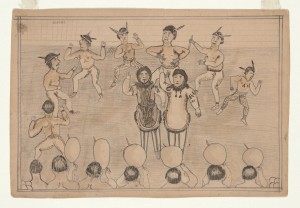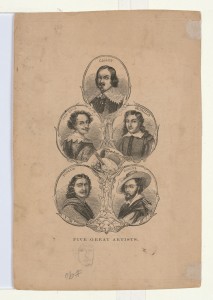Drawing K
two women dancers in different clothing
Notes on content:
Elizabeth Hutchinson (instructor) with thanks to Heidi Senengutuk for her help: The dancers in the center of this drawing are women. The men behind them wear yellow bill loon headdresses. The dance troupe are likely visitors to Kingigan from another village, possibly from the North Slope, where this kind of headdress is still worn, who have come to participate in the festival. The dance being shown may be an invitational dance. It is not part of the Wolf-Eagle Dance but could occur during the course of a Messenger Feast as a warm up.
Notes on form/style:
On the verso:
Emilie Chedeville (student): There is a unevenly shaped, but still compelling addition to the verso of this drawing, that I see as a self-portrait inserting the image of a sixth artist just under the engraved portraits of “Five great Artists.” From this interpretive perspective, we might see this Native artist expressing his conception of his own production as belonging to the Western artistic tradition and his right to claim his artistic talent, in a very humorous and moving way. Despite his acknowledgment of his relationship to Western tradition, he clearly stated his Inupiaqness, by representing his face in a typically round shape, alluding both to the facial type of Eskimo figure, and to their parka, edged with fur. The emulative part of this portrait goes further than a simple sketch or doodle. It stresses the self-definition of the Native student as able to produce art and his ability to develop this skill in response to both local graphic traditions and to incorporate new ideas from the media entering his world.
The skills of the portraitist here a expressed in a very signifying way, on the sheet’s recto. Indeed, one can feel the struggle between the will to emulate Western tradition, and the respect between Inupiat artistic tradition.


Leave a Reply
You must be logged in to post a comment.